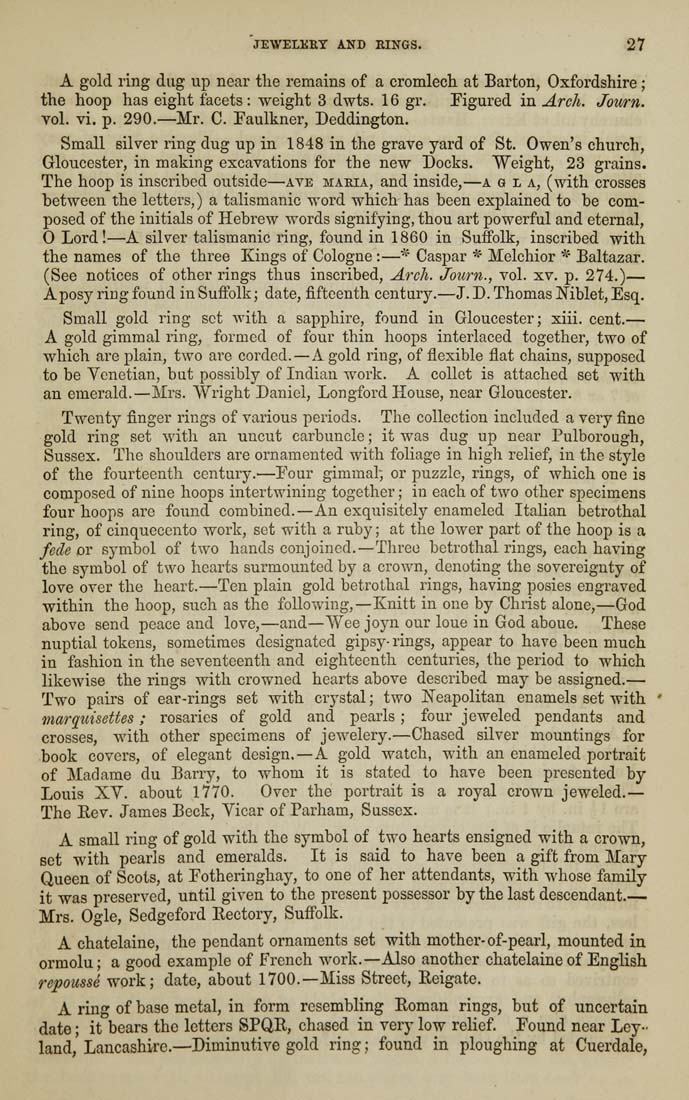JEWELERY AND BINGS.
27
A gold ring dug up near the remains of a cromlech at Barton, Oxfordshire;
the hoop has eight facets: weight 3 dwts. 16 gr. Figured in Arch. Journ.
vol. vi. p. 290.—Mr. C. Faulkner, Deddington.
Small silver ring dug up in 1848 in the grave yard of St. Owen's church,
Gloucester, in making excavations for the new Docks. Weight, 23 grains.
The hoop is inscribed outside—ave maria, and inside,—a g l a, (with crosses
between the letters,) a talismanic word which has been explained to be com¬
posed of the initials of Hebrew words signifying, thou art powerful and eternal,
0 Lord!—A silver talismanic ring, found in 1860 in Suffolk, inscribed with
the names of the three Xings of Cologne:—* Caspar * Melchior * Baltazar.
(See notices of other rings thus inscribed, Arch. Journ., vol. xv. p. 274.)—
A posy ring found in Suffolk; date, fifteenth century.'—J. D. Thomas Niblet, Esq.
Small gold ring set with a sapphire, found in Gloucester; xiii. cent.—
A gold gimmal ring, formed of four thin hoops interlaced together, two of
which are plain, two are corded.—A gold ring, of flexible flat chains, supposed
to be Venetian, but possibly of Indian work. A collet is attached set with
an emerald.—Mrs. Wright Daniel, Longford House, near Gloucester.
Twenty finger rings of various periods. The collection included a very fine
gold ring set with an uncut carbuncle; it was dug up near Pulborough,
Sussex. The shoulders are ornamented with foliage in high relief, in the style
of the fourteenth century.—Four gimmal; or puzzle, rings, of which one is
composed of nine hoops intertwining together; in each of two other specimens
four hoops are found combined.—An exquisitely enameled Italian betrothal
ring, of cinquecento work, set with a ruby; at the lower part of the hoop is a
fede or symbol of two hands conjoined.—Three betrothal rings, each having
the symbol of two hearts surmounted by a crown, denoting the sovereignty of
love over the heart.—Ten plain gold betrothal rings, having posies engraved
within the hoop, such as the following,—Knitt in one by Christ alone,—God
above send peace and love,—and—Wee joyn our loue in God aboue. These
nuptial tokens, sometimes designated gipsy-rings, appear to have been much
in fashion in the seventeenth and eighteenth centuries, the period to which
likewise the rings with crowned hearts above described may be assigned.—
Two pairs of ear-rings set with crystal; two Neapolitan enamels set with
marquisettes; rosaries of gold and pearls; four jeweled pendants and
crosses, with other specimens of jewelery.—Chased silver mountings for
book covers, of elegant design.—A gold watch, with an enameled portrait
of Madame du Barry, to whom it is stated to have been presented by
Louis XV. about 1770. Over the portrait is a royal crown jeweled.—
The Rev. James Beck, Vicar of Parham, Sussex.
A small ring of gold with the symbol of two hearts ensigned with a crown,
set with pearls and emeralds. It is said to have been a gift from Mary
Queen of Scots, at Fotheringhay, to one of her attendants, with whose family
it was preserved, until given to the present possessor by the last descendant___
Mrs. Ogle, Sedgeford Rectory, Suffolk.
A chatelaine, the pendant ornaments set with mother-of-pearl, mounted in
ormolu; a good example of French work.—Also another chatelaine of English
repoussi work; date, about 1700.—Miss Street, Reigate.
A ring of base metal, in form resembling Roman rings, but of uncertain
date; it bears the letters SPQR, chased in very low relief. Found near Ley-
land, Lancashire.—Diminutive gold ring; found in ploughing at Cuerdale,
|








